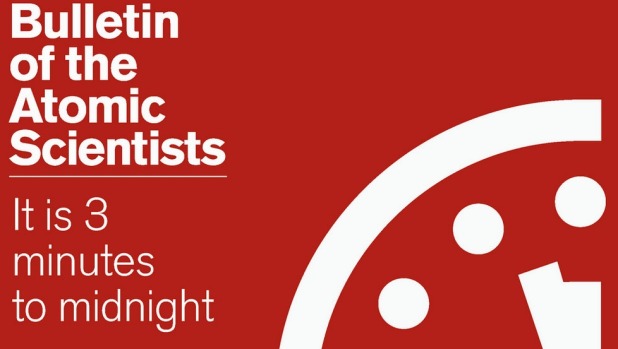
“A tutti i leader e cittadini del mondo – questo l’incipit della comunità scientifica del Bulletin di quest’anno – l’anno scorso, la comunità internazionale ha fatto alcuni passi avanti sulle due maggiori minacce che investono la vita dell’intera umanità: le armi nucleari e il cambiamento climatico. Nel mese di luglio 2015, alla fine di quasi due anni di negoziati, sei potenze mondiali e l’Iran hanno raggiunto uno accordo storico, che limita il programma nucleare iraniano per evitare che Teheran sviluppi armi nucleari. Inoltre, alla fine del 2015, quasi 200 Paesi, incontratisi a Parigi, si sono accordati su un processo che tenterà di ridurre le loro emissioni di anidride carbonica, per mantenere l’aumento della temperatura mondiale al di sotto di 2,0° C rispetto al valore pre-industriale. L’accordo nucleare con l’Iran e quello sul clima di Parigi, costituiscono però solo due piccoli punti luminosi in una situazione mondiale decisamente oscura e affollata da numerose potenziali catastrofi.
Nonostante l’accordo Iran, le tensioni tra Stati Uniti e Russia sono, infatti, salite a livelli che ricordano i periodi peggiori della guerra fredda. Anche i conflitti in Ucraina e in Siria continuano, accompagnati da tensioni pericolose con la Turchia. Sebbene quest’ultima sia membro della NATO ha di fatto abbattuto un aereo da guerra russo in Siria. La cosa ha innervosito parecchio il Cremlino, che attraverso il direttore di una agenzia stampa statale ha fatto sapere che la Russia non starà di certo a guardare. Così sebbene Washington e Mosca continuino ad aderire alla maggior parte degli accordi sul controllo degli armamenti nucleari già esistenti, in realtà, come tutti gli altri Paesi dotati di armi nucleari, tutti sono fortemente impegnati a modernizzare i loro attuali arsenali nucleari. Questo suggerisce che molto probabilmente intendono riservarsi la piena disponibilità dei loro arsenali di guerra ancora per decenni e in evidente contraddizzione con gli impegni già presi con il Trattato di non Proliferazione Nucleare che ha come scopo finale il disarmo nucleare.
Anche l’Accordo sul Clima raggiunto a Parigi, seppur promettente, avviene alla fine dell’anno più caldo registrato sul pianeta, con un aumento della temperatura globale, rispetto ai livelli pre-industriali, di oltre un grado Celsius. Gli impegni volontari assunti a Parigi, per limitare le emissioni di gas serra, non sono infatti sufficienti ad evitare cambiamenti climatici drastici, ma servono solo ad accelerare il processo di cambiamento dei sistemi energetici del mondo, uno degli elementi chiave per rallentare il cambiamento climatico in rapido aumento.
Le lancette del Doomsday Clock non arretrano
Nonostante i successi diplomatici in Iran e a Parigi, i rischi nucleari e climatici non sono affatto compensati. I membri del Bulletin of the Atomic Scientists ribadiscono, infatti, che le lancette dell’orologio sono a tre minuti prima della mezzanotte.
I membri del Bulletin of the Atomic Scientists hanno dichiarato che nel 2015 i leader mondiali non sono riusciti ad agire abbastanza in fretta per garantire all’umanità una sufficiente protezione dai pericoli rappresentati dal cambiamento climatico e dalle guerre nucleari: “La situazione mondiale rimane altamente minacciosa per l’intera Umanità ed è urgente agire un modo decisivo per ridurre il pericolo rappresentato dalle armi nucleari e dal cambiamento climatico.”
La capacità dei principali Stati dotati di armi nucleari a collaborare sulla “Non proliferazione nucleare” è uno dei pochi punti chiave per salvaguardare il mondo nel suo insieme.
Sebbene gli Stati Uniti e la Russia continuino a ridure le testate nucleari schierate, nel rispetto del nuovo trattato START, i programmi di modernizzazione nucleare per mantenere le proprie disponibilità procedono a ritmo sostenuto e si proiettano sul prossimo mezzo secolo. I russi hanno meno lanciatori, ma le loro forze in futuro saranno più mobili e le loro testate più flessibili e mirate. Anche gli Stati Uniti hanno in programma di spendere, nei prossimi 10 anni, 350 miliardi di dollari per mantenere e modernizzare le proprie forze nucleari e infrastrutture.
Non sembra proprio, quindi, che il mondo pensi di liberarsi dalle armi nucleari.
Anche il conflitto per liberare il passaggio del Mare Cinese Meridionale si sta sviluppando in modo preoccupante. La Cina, che rivendica la propria territorialità per quelle isole sulle quali si è allargata per scopi militari, viene contestata dai Paesi di quella regione. E considerando che gli Stati Uniti pretendo il libero passaggio nel Mar Cinese Meridionale, con l’invio di una nave da guerra e aerei propri giusto vicino a queste isole, il rischio cha la situazione degeneri in un grande conflitto tra potenze nucleari è assai alto.
Le prospettive che nel breve periodo si raggiunga quindi il controllo delle armi nucleari, al di là della situazione Stati Uniti e Russia, sono dunque alquanto sfavorevoli. Cina, Pakistan, India e Corea del Nord stanno tutti aumentando i loro arsenali nucleari, anche se a ritmi diversi. Il recente accordo della Cina per aiutare il Pakistan a costruire piattaforme di missili sottomarini nucleari è una questione di interessi, ma probabilmente meno rilevante dello sviluppo, invece, dell’arsenale del Pakistan nel suo complesso, compresi i miglioramenti dei suoi sistemi di lancio missilistici.
Nel frattempo, il leader nord coreano Kim Jong-un aveva annunciato alla fine dello scorso anno, che il suo Paese aveva sviluppato una bomba all’idrogeno, seguito da un test del 5 gennaio 2016. Fino ad ora, gli esperti hanno valutato che probabilmente non era un’arma termonucleare a due stadi, ma non c’è dubbio che la Corea del Nord continuerà a sviluppare il suo arsenale nucleare, in assenza di vincoli.
Anche l’accordo di Parigi sui cambiamenti climatici, acclamato come “pietra miliare” dal Segretariato delle Nazioni Unite, è stato riconosciuto valido a patto che tutti i Paesi rispettino i loro impegni “volontari”. In tal caso entro il 2025, il mondo avrà usato la metà del restante bilancio di anidride carbonica e sarà in linea con l’obiettivo dei 2 °C che si è dato. Di questo bilancio, i tre quarti delle emissioni di carbonio verranno esaurite entro il 2030. Questo calcolo presume però che ogni Paesi rispetti fino in fondo gli impegni presi. In realtà l’accordo di Parigi non prevede meccanismi efficaci che assicurino che ciascun paese lo rispetti veramente. Così il successo dell’accordo dipenderà in definitiva dalla buona fede e dalla buona volontà dei firmatari. È importante sottolineare che gli impegni presi da parte dei Paesi in via di sviluppo, in particolare dalla Cina, in proporzione, saranno superiori a quelli dei Paesi sviluppati. Questi impegni riconoscono che la soluzione del problema climatico richiede al mondo in via di sviluppo di limitare di fatto il suo sviluppo, anche se il clima è stato portato al suo rischio attuale proprio dalle alte emissioni che il mondo sviluppato ha provocato nel passato.
Un contributo posito è stato, invece, dato dall’enciclica papale “Laudato Si”, che in modo potente e convincente ha espresso l’imperativo morale di frenare l’impatto umano sul clima, favorendo l’impegno di un crescente numero di aziende, istituzioni educative, gruppi religiosi e investitori istituzionali che hanno dimostrato il loro sostegno attraverso il disinvestimento in società di combustibili fossili e promuovendo iniziative a favore di sistemi energetici più sostenibili.
Il vuoto nella leadership nucleare.
L’energia nucleare fornisce poco più del 10% della capacità elettrogena del mondo e in alcuni paesi, in particolare Cina e altri Paesi del Medio Oriente, sono stati annunciati programmi ambiziosi di espansione della loro capacità nucleare che scaturiscono dalla crescente esigenza di energia per affrontare proprio il cambiamento climatico. Ma la comunità internazionale non ha sviluppato piani coordinati per affrontare i costi che scaturirebbero, in termini di sicurezza e gestione delle scorie radioattive, da una espansione nucleare su così larga scala. I programmi degli Stati Uniti per la gestione dei rifiuti provenienti dai programmi di difesa, per lo smantellamento delle armi nucleari e per lo stoccaggio del combustibile nucleare commercialmente generato, spesso è dispersivo. I grandi progetti, tra cui un impianto di combustibile a Savannah River Site, destinato a fondere il surplus di plutonio weapon-grade con l’uranio, in modo che possa essere usato in centrali nucleari di imprese commerciali è sempre più in ritardo, e i costi continuano ad aumentare. La spesa del Dipartimento dell’Energia degli Stati Uniti , per la gestione ambientale dei rifiuti nucleari, è di 5,8 miliardi di dollari all’anno, eredità dei programmi di armamenti statunitensi. A causa di questi problemi, negli Stati Uniti e in altri Paesi, l’attrattiva nucleare come alternativa ai combustibili fossili è quindi diminuita.
Anche le emergenti minacce tecnologiche richiedono maggior attenzione. Il rapido ritmo di sviluppo tecnologico obbliga, infatti, i leader mondiali a controllare di più i potenziali emergenti della scienza che potrebbero diventare anch’essi una grave minaccia per l’umanità.
E ‘chiaro che i progressi nella biotecnologia, nel campo dell’intelligenza artificiale, e in particolare per l’uso di armi robotiche, e nel regno di tutto il cyber hanno creato un potenziale di rischi su scala globale.
I membri del Bulletin of the Atomic Scientists sottolineano un forte ritardo nello sviluppo di tecnologie che permettano alla società civile un maggior controllo sulla Scienza e sulla Tecnologia: “La comunità internazionale deve rafforzare le istituzioni esistenti che regolano le tecnologie emergenti e creare nuovi forum per esplorarne i potenziali rischi, anche proponendo potenziali controlli su quelle aree di progresso scientifico e tecnologico che sono state per molto tempo prive di una supervisione sociale.”
L’anno scorso, i membri del Bulletin of the Atomic Scientists hanno spostato il Doomsday Clock in avanti a tre minuti dalla mezzanotte, sottolineando che: “La probabilità di una catastrofe globale è molto alta e le azioni necessarie per ridurla devono essere prese al più presto.”
Questa probabilità nel frattempo non si è ridotta. L’orologio fa tic tac e il pericolo globale incombe. Sarebbe saggio agire subito!
(Estratto parziale dell’ultimo “Bulletin of the Atomic Scientists”)
Cronologia della linea temporale del DoomsdayClock
2016: 3 minuti
2016: “Last year, the Science and Security Board moved the Doomsday Clock forward to three minutes to midnight, noting: ‘The probability of global catastrophe is very high, and the actions needed to reduce the risks of disaster must be taken very soon.’ That probability has not been reduced. The Clock ticks. Global danger looms. Wise leaders should act—immediately.” See the full statement from the Science and Security Board on the 2016 time of the Doomsday Clock.2012: 5 minuti
2012: “The challenges to rid the world of nuclear weapons, harness nuclear power, and meet the nearly inexorable climate disruptions from global warming are complex and interconnected. In the face of such complex problems, it is difficult to see where the capacity lies to address these challenges.” Political processes seem wholly inadequate; the potential for nuclear weapons use in regional conflicts in the Middle East, Northeast Asia, and South Asia are alarming; safer nuclear reactor designs need to be developed and built, and more stringent oversight, training, and attention are needed to prevent future disasters; the pace of technological solutions to address climate change may not be adequate to meet the hardships that large-scale disruption of the climate portends.2010: 6 minuti
2010: “We are poised to bend the arc of history toward a world free of nuclear weapons” is the Bulletin’s assessment. Talks between Washington and Moscow for a follow-on agreement to the Strategic Arms Reduction Treaty are nearly complete, and more negotiations for further reductions in the U.S. and Russian nuclear arsenal are already planned. The dangers posed by climate change are growing, but there are pockets of progress. Most notably, at Copenhagen, the developing and industrialized countries agree to take responsibility for carbon emissions and to limit global temperature rise to 2 degrees Celsius.2007: 5 minuti
2007: The world stands at the brink of a second nuclear age. The United States and Russia remain ready to stage a nuclear attack within minutes, North Korea conducts a nuclear test, and many in the international community worry that Iran plans to acquire the Bomb. Climate change also presents a dire challenge to humanity. Damage to ecosystems is already taking place; flooding, destructive storms, increased drought, and polar ice melt are causing loss of life and property.2002: 7 minuti
2002: Concerns regarding a nuclear terrorist attack underscore the enormous amount of unsecured–and sometimes unaccounted for–weapon-grade nuclear materials located throughout the world. Meanwhile, the United States expresses a desire to design new nuclear weapons, with an emphasis on those able to destroy hardened and deeply buried targets. It also rejects a series of arms control treaties and announces it will withdraw from the Anti-Ballistic Missile Treaty.1998: 9 minuti
1998: India and Pakistan stage nuclear weapons tests only three weeks apart. “The tests are a symptom of the failure of the international community to fully commit itself to control the spread of nuclear weapons–and to work toward substantial reductions in the numbers of these weapons,” a dismayed Bulletin reports. Russia and the United States continue to serve as poor examples to the rest of the world. Together, they still maintain 7,000 warheads ready to fire at each other within 15 minutes.1995: 14 minuti
1995: Hopes for a large post-Cold War peace dividend and a renouncing of nuclear weapons fade. Particularly in the United States, hard-liners seem reluctant to soften their rhetoric or actions, as they claim that a resurgent Russia could provide as much of a threat as the Soviet Union. Such talk slows the rollback in global nuclear forces; more than 40,000 nuclear weapons remain worldwide. There is also concern that terrorists could exploit poorly secured nuclear facilities in the former Soviet Union.1991: 17 minuti
1991: With the Cold War officially over, the United States and Russia begin making deep cuts to their nuclear arsenals. The Strategic Arms Reduction Treaty greatly reduces the number of strategic nuclear weapons deployed by the two former adversaries. Better still, a series of unilateral initiatives remove most of the intercontinental ballistic missiles and bombers in both countries from hair-trigger alert. “The illusion that tens of thousands of nuclear weapons are a guarantor of national security has been stripped away,” the Bulletin declares.1990: 10 minuti
1990: As one Eastern European country after another (Poland, Czechoslovakia, Hungary, Romania) frees itself from Soviet control, Soviet General Secretary Mikhail Gorbachev refuses to intervene, halting the ideological battle for Europe and significantly diminishing the risk of all-out nuclear war. In late 1989, the Berlin Wall falls, symbolically ending the Cold War. “Forty-four years after Winston Churchill’s ‘Iron Curtain’ speech, the myth of monolithic communism has been shattered for all to see,” the Bulletin proclaims.
1988: 6 minuti
1988: The United States and Soviet Union sign the historic Intermediate-Range Nuclear Forces Treaty, the first agreement to actually ban a whole category of nuclear weapons. The leadership shown by President Ronald Reagan and Soviet Premier Mikhail Gorbachev makes the treaty a reality, but public opposition to U.S. nuclear weapons in Western Europe inspires it. For years, such intermediate-range missiles had kept Western Europe in the crosshairs of the two superpowers.1984: 3 minuti
1984: U.S.-Soviet relations reach their iciest point in decades. Dialogue between the two superpowers virtually stops. “Every channel of communications has been constricted or shut down; every form of contact has been attenuated or cut off. And arms control negotiations have been reduced to a species of propaganda,” a concerned Bulletin informs readers. The United States seems to flout the few arms control agreements in place by seeking an expansive, space-based anti-ballistic missile capability, raising worries that a new arms race will begin.1981: 4 minuti
1981: The Soviet invasion of Afghanistan hardens the U.S. nuclear posture. Before he leaves office, President Jimmy Carter pulls the United States from the Olympic Games in Moscow and considers ways in which the United States could win a nuclear war. The rhetoric only intensifies with the election of Ronald Reagan as president. Reagan scraps any talk of arms control and proposes that the best way to end the Cold War is for the United States to win it.1980: 7 minuti
1980: Thirty-five years after the start of the nuclear age and after some promising disarmament gains, the United States and the Soviet Union still view nuclear weapons as an integral component of their national security. This stalled progress discourages the Bulletin: “[The Soviet Union and United States have] been behaving like what may best be described as ‘nucleoholics’–drunks who continue to insist that the drink being consumed is positively ‘the last one,’ but who can always find a good excuse for ‘just one more round.'”1974: 9 minuti
1974: South Asia gets the Bomb, as India tests its first nuclear device. And any gains in previous arms control agreements seem like a mirage. The United States and Soviet Union appear to be modernizing their nuclear forces, not reducing them. Thanks to the deployment of multiple independently targetable reentry vehicles (MIRV), both countries can now load their intercontinental ballistic missiles with more nuclear warheads than before.1972: 12 minuti
1972: The United States and Soviet Union attempt to curb the race for nuclear superiority by signing the Strategic Arms Limitation Treaty (SALT) and the Anti-Ballistic Missile (ABM) Treaty. The two treaties force a nuclear parity of sorts. SALT limits the number of ballistic missile launchers either country can possess, and the ABM Treaty stops an arms race in defensive weaponry from developing.1969: 10 minuti
1969: Nearly all of the world’s nations come together to sign the Nuclear Non-Proliferation Treaty. The deal is simple–the nuclear weapon states vow to help the treaty’s non-nuclear weapon signatories develop nuclear power if they promise to forego producing nuclear weapons. The nuclear weapon states also pledge to abolish their own arsenals when political conditions allow for it. Although Israel, India, and Pakistan refuse to sign the treaty, the Bulletin is cautiously optimistic: “The great powers have made the first step. They must proceed without delay to the next one–the dismantling, gradually, of their own oversized military establishments.”1968: 7 minuti
1968: Regional wars rage. U.S. involvement in Vietnam intensifies, India and Pakistan battle in 1965, and Israel and its Arab neighbors renew hostilities in 1967. Worse yet, France and China develop nuclear weapons to assert themselves as global players. “There is little reason to feel sanguine about the future of our society on the world scale,” the Bulletin laments. “There is a mass revulsion against war, yes; but no sign of conscious intellectual leadership in a rebellion against the deadly heritage of international anarchy.”1963: 12 minuti
1963: After a decade of almost non-stop nuclear tests, the United States and Soviet Union sign the Partial Test Ban Treaty, which ends all atmospheric nuclear testing. While it does not outlaw underground testing, the treaty represents progress in at least slowing the arms race. It also signals awareness among the Soviets and United States that they need to work together to prevent nuclear annihilation.1960: 7 minuti
1960: Political actions belie the tough talk of “massive retaliation.” For the first time, the United States and Soviet Union appear eager to avoid direct confrontation in regional conflicts such as the 1956 Egyptian-Israeli dispute. Joint projects that build trust and constructive dialogue between third parties also quell diplomatic hostilities. Scientists initiate many of these measures, helping establish the International Geophysical Year, a series of coordinated, worldwide scientific observations, and the Pugwash Conferences, which allow Soviet and American scientists to interact.1953: 2 minuti
1953: After much debate, the United States decides to pursue the hydrogen bomb, a weapon far more powerful than any atomic bomb. In October 1952, the United States tests its first thermonuclear device, obliterating a Pacific Ocean islet in the process; nine months later, the Soviets test an H-bomb of their own. “The hands of the Clock of Doom have moved again,” the Bulletin announces. “Only a few more swings of the pendulum, and, from Moscow to Chicago, atomic explosions will strike midnight for Western civilization.”1949: 3 minuti
1949: The Soviet Union denies it, but in the fall, President Harry Truman tells the American public that the Soviets tested their first nuclear device, officially starting the arms race. “We do not advise Americans that doomsday is near and that they can expect atomic bombs to start falling on their heads a month or year from now,” the Bulletin explains. “But we think they have reason to be deeply alarmed and to be prepared for grave decisions.”1947: 7 minuti
1947: As the Bulletin evolves from a newsletter into a magazine, the Clock appears on the cover for the first time. It symbolizes the urgency of the nuclear dangers that the magazine’s founders–and the broader scientific community–are trying to convey to the public and political leaders around the world.
di Adriana Paolini
Linkografia:

























febbraio 2nd, 2016 at 00:40
https://www.youtube.com/watch?v=2G-7xykTO14